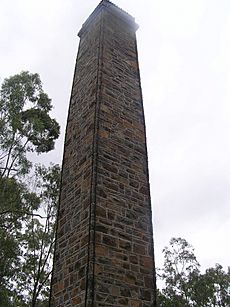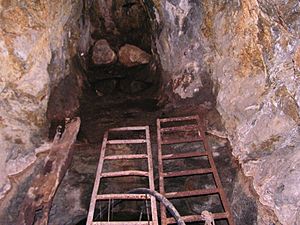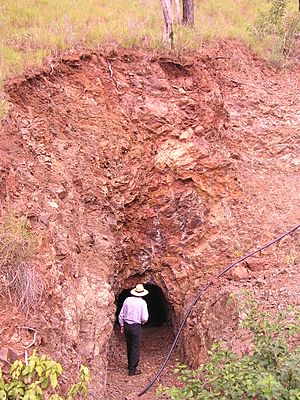Mount Clara smelter facts for kids
Quick facts for kids Mount Clara smelter |
|
|---|---|

Mount Clara smelter and chimney, taken in 2009. Modern tourist signs indicate from left to right, Furnace, Timber Railway, Fireplace. At the centre rear is the hearth
|
|
| Location | Rossmore Road, Oakview, Gympie Region, Queensland, Australia |
| Design period | 1870s–1890s (late 19th century) |
| Built | 1873 |
| Official name: Mount Clara Smelter | |
| Type | state heritage (archaeological) |
| Designated | 21 October 1992 |
| Reference no. | 600640 |
| Significant period | 1873 (fabric) 1873–1875 (historical) |
| Significant components | chimney/chimney stack, slag pile/slag heap, fire box |
| Lua error in Module:Location_map at line 420: attempt to index field 'wikibase' (a nil value). | |
The Mount Clara smelter is a historic site in Queensland, Australia. It used to be a place where copper ore was melted down to get pure copper. This process is called smelting. The smelter was built in 1873 near Oakview, which is close to Kilkivan.
Today, most of the smelter is in ruins. However, its tall chimney is still standing. It reminds us of a time when copper mining was very active in this area. The site is now protected as part of the Queensland Heritage Register.
Contents
Discovering Copper: A Look at the Past
The Copper Boom and Early Mining
In the 1860s and 1870s, copper was very valuable. Its price could reach as high as UK £95 per ton. People started mining copper in the Mount Clara and Mount Coora areas around 1872. The Mount Clara smelter was built quickly in 1873. Workers used local rocks and sand from Fraser Island to build it.
The Mount Clara smelter was one of the first in Queensland. It was built after other smelters like Peak Downs and Mount Perry. It started operating a year before others in Mount Coora and Blackall.
How the Smelter Worked
An early report from 1872 showed good results. About 8 tons of copper were produced from 60 tons of ore. This meant that 13 percent of the ore was pure copper. The leftover waste, called slag, was poured into the nearby creek. You can still see large chunks of it today.
The copper ore found here was a rich blue-green color. It came from a thick layer about 10 feet deep. This ore was perfect for the type of furnace used at Mount Clara. This furnace was called a reverberatory furnace.
The smelter ran all the time. It needed three shifts of six men working on the furnace. Around 300 men also worked in the mines nearby. It's thought that between 10,000 and 12,000 people lived in the area back then. The main mine was about 1 mile away and much higher up.
Why the Smelter Closed Down
The Mount Clara smelter only operated for a short time, closing in 1875. The Mount Coora Copper Mining Company bought the Mount Clara mines in 1874. After this, copper ore from Mount Clara was taken to the Mount Coora smelter instead.
One reason for this change might have been the distance. The Mount Clara mine was 2 miles from its own smelter. This meant ore had to be transported a long way. All mining in the area stopped by 1886. Other smelters in the region also closed down. The high cost of fuel for the smelters was a big reason for these closures.
Protecting History: Conservation and Tourism
Restoring the Smelter Site
The Kilkivan Shire Council worked to restore the historic Mount Clara Copper Smelter. They received help from the National Trust of Australia. The tall chimney was fully repaired and safety fences were put up. The road leading to the site was also made safer for visitors.
The Mount Clara Chimney is now officially recognized by the National Trust of Queensland. It is also listed on the Queensland Heritage Register.
Visiting the Historic Site
Today, the chimney is a popular spot for tourists in the Kilkivan area. It is located about 3 kilometers off Rossmore Road. This is about 13 kilometers by road from Kilkivan town. The site is special because it feels very old and untouched by modern buildings. It truly shows what early mining was like.
What Remains: A Look at the Smelter Today
The Smelter Ruins
The smelter remains were repaired by the Kilkivan Shire Council in 1978. You can see the brick and stone walls at ground level. The walls are about 170 centimeters high at one end and 120 centimeters at the other. This shows where the arched roof, which has now fallen, used to be.
You can clearly see the oval shape inside the smelter. The fire-box, where the heat was made, is very well preserved. It has a deep area for access below ground. Iron supports are still in the base of the smelter. These likely held the metal bars that kept the smelter together.
The Slag Heap
Near the smelter is a small pile of slag. Slag is the waste material left over after melting ore. This pile is about 22 by 11 meters. It contains large, square blocks of slag. Each block is about 80 x 40 x 15 centimeters.
West of the smelter, you can see an area of broken bricks. This is probably where rubble from the 1978 repairs was dumped. A wire fence was put around the smelter and chimney in 1978. This helps protect the remains and keeps visitors safe.
The Tall Chimney
The chimney is believed to be the oldest mining chimney still standing in Queensland. It was also one of the first ever built. It stands about 13.8 meters (or about 45 feet) high. Early reports said it was even taller, around 66 feet.
The chimney was built using local bluestone. Iron clamps and a mix of lime and sand held it together. The special bricks lining the furnace and chimney were made from good quality local clay. The chimney stands very close to the smelter. You can clearly see where the smelter's smoke pipe, now collapsed, entered the chimney about 180 centimeters up.
The Old Mine
The copper ore came from a mine shaft dug into the mountain. This mine was about 1 mile away from the smelter. The mine tunnel has an arched roof and no upright supports. This style is thought to be similar to what miners from Cornwall, England, used.
The entrance to the mine was found again and opened in the 1980s. Some more exploration was done over the next few years. However, no new mining operations ever started. For safety reasons, the mine entrance has since been sealed up. The mine itself is on private land and is not part of the heritage-listed area.
Why It's Important: Heritage Listing
The Mount Clara smelter was added to the Queensland Heritage Register on October 21, 1992. It met several important requirements:
- Showing Queensland's History: The smelter helps us understand how base metal mining developed in Queensland. It's one of the few well-preserved smelters from the 1870s.
- A Rare Part of History: Smelters from this time that are still in good condition are very rare in Queensland. The smelter chimney might even be the oldest mining chimney still standing in the state.
- Learning from the Site: The site could still hold clues that help us learn more about this period. It could also teach us about early mining in the Maryborough district.




